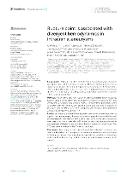Rupture point is associated with divergent hemodynamics in intracranial aneurysms

Author
Víteček, Jan
Vítečková Wunschová, Andrea
Hundža Stratilová, Mária
Radovnický, Tomáš
Publication date
2024Published in
Frontiers in NeurologyVolume / Issue
15 (may)ISBN / ISSN
ISSN: 1664-2295Metadata
Show full item recordCollections
This publication has a published version with DOI 10.3389/fneur.2024.1364105
Abstract
Background Understanding the risk factors leading to intracranial aneurysm (IA) rupture have still not been fully clarified. They are vital for proper medical guidance of patients harboring unruptured IAs. Clarifying the hemodynamics associated with the point of rupture could help could provide useful information about some of the risk factors. Thus far, few studies have studied this issue with often diverging conclusions.Methods We identified a point of rupture in patients operated for an IAs during surgery, using a combination of preoperative computed tomography (CT) and computed tomography angiography (CTA). Hemodynamic parameters were calculated both for the aneurysm sac as a whole and the point of rupture. In two cases, the results of CFD were compared with those of the experiment using particle image velocimetry (PIV).Results We were able to identify 6 aneurysms with a well-demarcated point of rupture. In four aneurysms, the rupture point was near the vortex with low wall shear stress (WSS) and high oscillatory shear index (OSI). In one case, the rupture point was in the flow jet with high WSS. In the last case, the rupture point was in the significant bleb and no specific hemodynamic parameters were found. The CFD results were verified in the PIV part of the study.Conclusion Our study shows that different hemodynamic scenarios are associated with the site of IA rupture. The numerical simulations were confirmed by laboratory models. This study further supports the hypothesis that various pathological pathways may lead to aneurysm wall damage resulting in its rupture.
Keywords
intracranial aneurysm, computational fluid dynamics, rupture, particle image velocimetry (PIV), wall shear stress (WSS),
Permanent link
https://hdl.handle.net/20.500.14178/2957License
Full text of this result is licensed under: Creative Commons Uveďte původ 4.0 International







